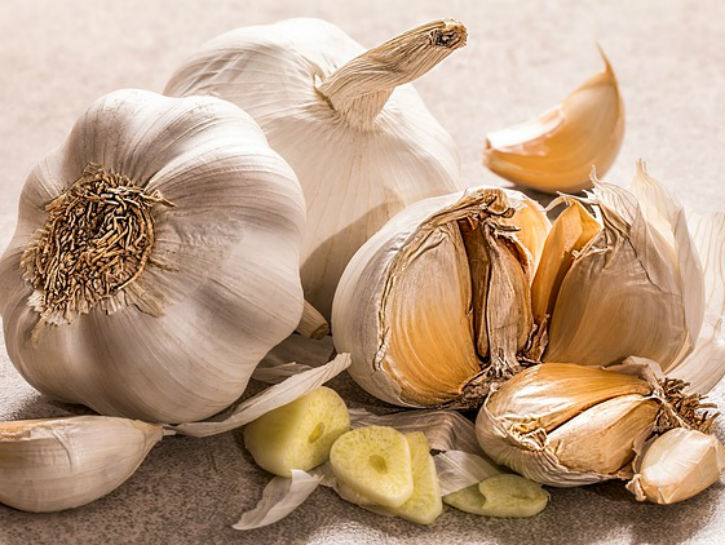The one cooking ingredient I can’t imagine living life without is garlic — and I know I’m not alone. For thousands of years, garlic has been a principal flavor in food prepared all over the world. But somehow, over time we started taking garlic for granted, instead of treating it with the respect it deserves.
When you cook garlic, do you singe the edges and give it a crunchy texture? Does the garlic smell pungent or harsh? Does it taste bitter? If you are having any of these problems, chances are you are making a mistake or two when cooking garlic.
Here are the six most common mistakes you can make when cooking garlic. But don’t worry. It is easy to make these mistakes, but it is just as easy to fix them.
1. Using Pre-Minced Garlic

It makes sense that you would want to save time and avoid getting your hands sticky and smelly, but that is no excuse for using pre-minced garlic. Fresh garlic is what makes food great, and those jars of pre-minced garlic in olive oil is a sad and unacceptable substitute.
Unlike fresh garlic, you have no idea how old the pre-minced garlic is or where it came from. Plus, it is possible that the pre-minced garlic has been bleached and peeled with a blast of air. And, there is also a possibility that it was soaked in water and contains added phosphoric acid (which is what you would use to remove rust).
If you use pre-minced garlic, it will give your food a funky taste. Simply put, pre-minced garlic is a million times inferior to fresh garlic.
2. Buying Old Garlic

When you are buying fresh garlic in the grocery store, there are some things to look for to make sure it is as fresh as possible. You don’t want the outside cloves to be soft or dry, and it is past its prime if there is a green stem sprouting from the middle. Signs of rot or discoloration is also an indication that the garlic is old.
Older garlic gets sharper and spicier, which can give your food a less than pleasant taste.
3. Peeling Inefficiently

Using the side of a knife to remove garlic clove skins can be a little nerve-racking, but peeling garlic correctly is important. If you don’t like using a knife, break your bulb into cloves and then place them in a mason jar before closing the lid. Then, shake it violently for about 30 seconds, so you can loosen the skins and remove them by hand.
Another method is to lay a large chef’s knife flat on top of the clove, then smack the knife to crush it. This will break the skin, and you can peel it by hand.
4. Chopping Garlic Instead of Grating It

Chopping or mincing garlic is a task commonly called for in recipes. However, there is an easier way to get your garlic in small pieces, and it will give you a better result and keep it from burning. If you use a Microplane grater on your peeled cloves, it is a much more efficient method than chopping with a knife.
It also helps your garlic retain its moisture, which is a safeguard against charring, and grating will leave your garlic in smaller, fluffier bits. That means that the garlic will incorporate seamlessly into any dish where texture is important, like a dressing or aioli.
5. Giving It Too Much Heat

Garlic burns very easily, especially when it is chopped, sliced, or grated because the smaller pieces cook quicker. To avoid burning your garlic, do not add it to the pan until you are at least halfway through the recipe. This will give it less time to burn, plus other ingredients will give it a cushion from the hot pan.
If you are cooking garlic for a sauce, sauté it quickly in oil — it only takes about 30 seconds to a minute for garlic to release its aroma and flavor — and then immediately add the liquid element for the sauce so you can bring down the temperature and avoid burning the garlic.
Also, when cooking garlic, it is best to use low to medium heat, and turn it up as needed. If you use high heat, the garlic will end up crispy and less than delicious. It could even end up burnt.
When roasting garlic, you also want to be careful with the temperature. Halving a head of garlic and rubbing it with oil, then wrapping it with foil before baking will make the garlic sweet, creamy, and spreadable. But, if your oven is over 375 degrees, you will burn the edges before it softens.
6. Not Having Liquid Handy

Like we said earlier, it takes less than a minute over low-to-medium heat for your chopped garlic to cook. So, you need to be prepared for the garlic to turn to a light golden color, and at that crucial moment you need to add some liquid or a wet ingredient to the pan. This will immediately lower the pan’s temperature and spare your garlic from burning.
Now that you know the right way to prepare and cook garlic, you can add delicious flavor to any recipe without making any mistakes.
